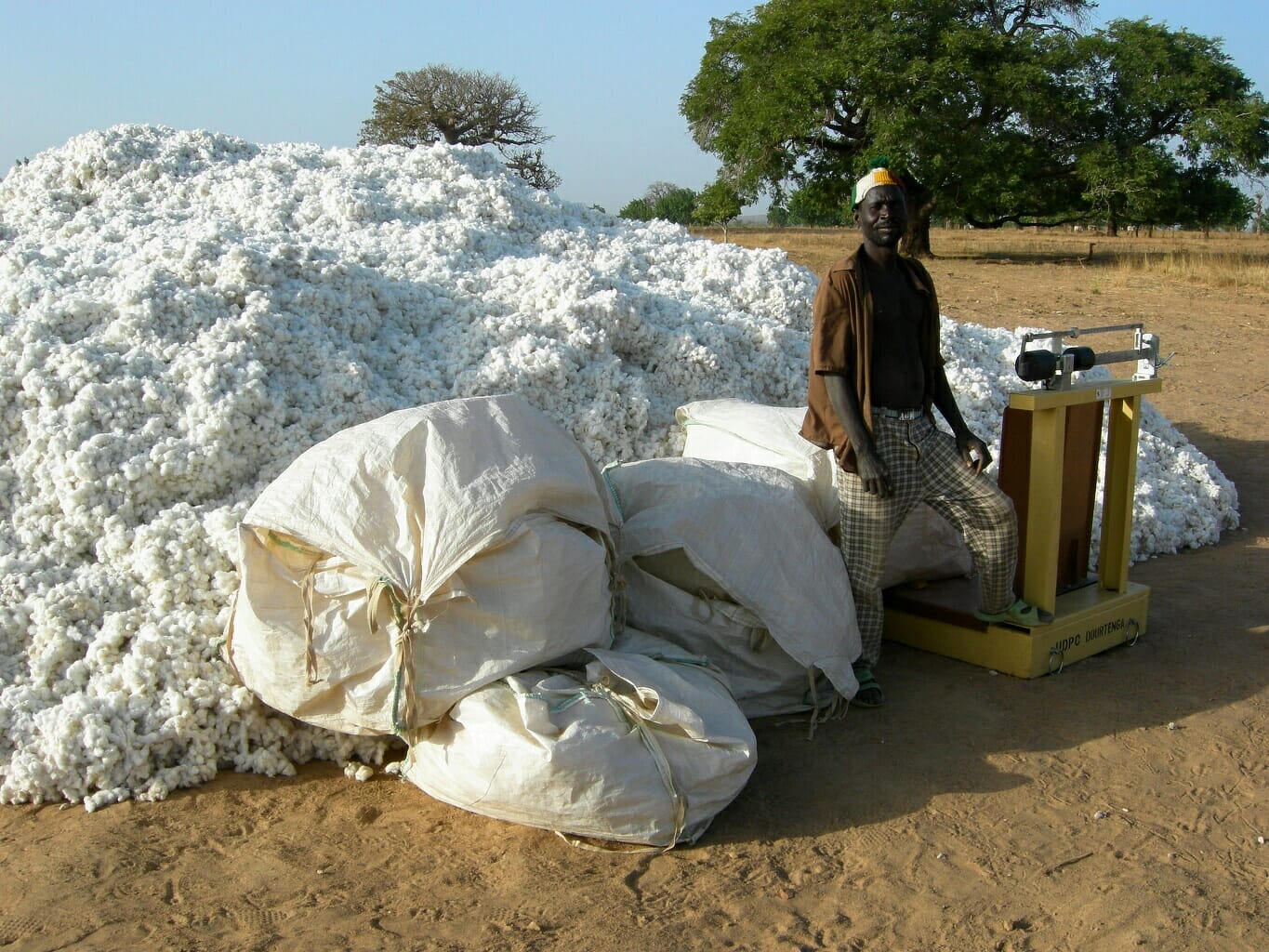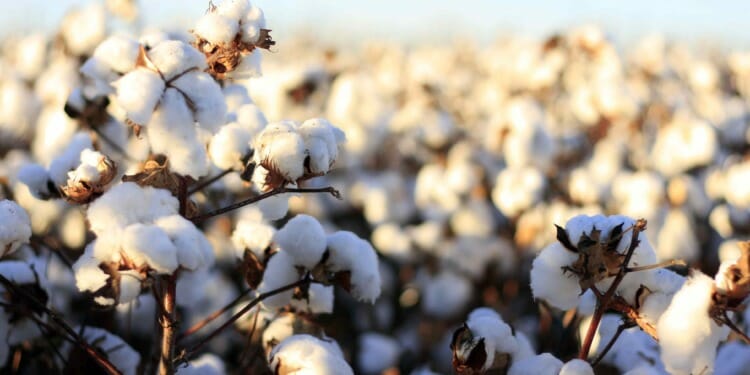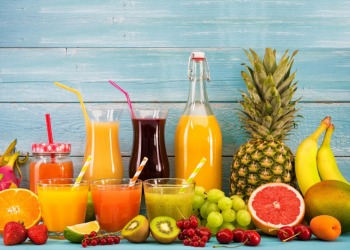Cotton is one of the most water-intensive and least pest-resistant crops, but it accounts for a quarter of global textile production. Mostly grown in semi-arid, water-scarce areas, cotton cultivation covers 2.5 percent of the world’s arable land involving some 20 million farmers, and absorbs eight to ten percent of the world’s pesticides. We break down the environmental impacts of this natural fabric and examine the different ways in which it’s grown.
Water consumption: Cotton is a thirsty crop. According to the Water Footprint Network, it takes between 5,000 and 27,000 liters of water to produce just one kilogram of fiber. To put things into perspective, it requires 2,700 liters of water to make one t-shirt, which weighs about 120 grams.
Pesticides: Because of its sensitivity to insects and pests, massive amounts of pesticides are used in cotton cultivation. Global demand has spurred the mass conversion of lands into cotton fields, even in places where the environmental conditions are not conducive to its growth. This requires more chemical inputs in the form of fertilizers, pesticides, and herbicides. Cotton cultivation accounts for ten percent of all the pesticides used in the world, despite it taking up less than three percent of arable land. In countries that lack adequate environmental safeguards, pesticides can contaminate the soil and water sources, posing massive health risks to farmers and their communities.
Chemical treatments and dyes: Once woven into yarn, cotton undergoes a series of chemical treatments, including bleaching with soap, hydrochloric acid, and trichlorethylene. Total bleaching is done with hydrogen peroxide or bleaching chloride. Consequently, water sources around cotton mills and factories can become highly polluted and are no longer safe for communities around them to drink, swim in, or use for agricultural purposes.
Chemical dyes are a major reason why the fast fashion industry is responsible for 17-20 percent of global water pollution. Textile dyeing alone is the world’s second biggest polluter of water. Like other aspects of cotton production, dye not only affects the environment, but people too. Chemicals do not disappear, but linger long enough for us to come into contact with them on a daily basis. Consequently, many people are developing allergic reactions to cotton clothing, particularly in response to formaldehyde resin, a chemical that makes clothes wrinkle-resistant. Side effects include irritation, nose bleeds, headaches, and nausea.

Different Types
Not all cotton is produced in the same way. Today, several labels and certifications claim to use more sustainable production methods. It’s important to understand how they differ to know which are sustainably-produced and which are not.
Conventional Cotton
There’s a high likelihood that this kind of cotton was grown from genetically-modified seeds with the addition of chemical fertilizer and pesticides, and vast amounts of water. Conventional cotton therefore has the biggest environmental impact, including water pollution, ground contamination, land degradation, and disease.
Non-Certified Organic Cotton
It is important not to be misled by packaging or promotions because, as indicated in its name, a non-certified organic cotton is not the same as fully organic cotton and may, in fact, have more in common with conventional cotton. Labels will sometimes indicate that a small part of the process is organic, or that the supplier is also producing organic cotton, but this is not a guarantee that the cotton found in this particular item is organic.
As none of the process has been verified or controlled, there is no certainty that the cotton is actually organic. The certification of all stages of production is therefore the only way to guarantee traceability and to ultimately determine whether a product is made with real organic cotton.
When buying cotton products, it is also important to note that global sales of organic cotton appear to exceed its production, which suggests that some companies may be lying about how organic their cotton actually is.
BCI Cotton
The Better Cotton Initiative (BCI), a global not-for-profit organisation, is the largest sustainable cotton programme in the world. BCI aims to help cotton communities survive and thrive, while protecting and restoring the environment through less resource intensive cultivation methods. They also offer social protections for farmers though training and capacity building, and strictly monitor supply chains to ensure that the volume of Better Cotton claimed by retailers and brand members does not exceed the volume produced by licensed Better Cotton Farmers in any given time period.
Organic Cotton in Conversion
Cotton in conversion is organic cotton grown on agricultural land that has recently been adapted for organic methods – that’s less than three years for the USA and less than two years for Europe. The ‘in conversion’ label therefore indicates that whilst the process of growing the cotton is organic, the soil is still in the process of being rinsed and cleaned of the toxicity of the chemicals (fertilizers, pesticides and insecticides) used on conventional fields. A lot of brands use cotton in conversion because of its cheaper than certified organic cotton grown in fully organic farms.
Organic Content Standard – OCS
The Organic Content Standard (OCS) is an international, voluntary standard that sets requirements for third-party certification for organic products. Having a product certified by a voluntary third-party comes with the assurance that every step in the supply chain has taken all the necessary measures to track the raw material as it moves from the source to the final product. The OCS certification attests that cotton is grown without GMOs, without chemicals (fertilizers, pesticides and insecticides), and with traceability from the cotton fields to the end customer. The goal of the OCS is to increase organic agriculture production.
Organic Cotton Certified – GOTS
A Global Organic Textile Standard (GOTS) certification ensures that the use of natural fibers (cotton, linen, hemp, silk, wool) is grown in compliance with the Organic Agriculture principles, that is, without the use of synthetic chemical inputs, or GMOs. The standard covers the processing, manufacturing, packaging, labelling, trading and distribution of all textiles made from at least 70 percent certified organic natural fibres and comes with strict requirements for environmental management that often go beyond the standards of the producing country. For example, wastewater from all wet processing units, should be treated in an internal or external functional wastewater treatment plant before being discharged to environment, and there are limits to how much wastewater can be generated for each kilo of textile produced.
Fairtrade Cotton
Fairtrade cotton is grown by farmers who are Fairtrade certified through their agricultural cooperative. They receive a premium price for each kilo of cotton sold to a Fairtrade certified brand, which improves farmer livelihoods. Requirements in the Fairtrade Standards also protect farmers’ health and safety, and ban genetically modified cotton seeds. They work with farmers to reduce the use of chemicals and supports them in adapting to changing climate patterns. Fairtrade cotton fields in India and West Africa, for example, are naturally irrigated, significantly reducing the region’s water footprint.
Cotton production has massive environmental and social impacts. One way to encourage more sustainable production is to opt for products that are certified organic and adequately support farmer livelihoods. However, given how difficult it can be to ascertain the validity of a product’s organic certifications, it’s always a good idea to choose natural fabrics with a significantly smaller environmental footprint when in doubt, such as flax, vicuna, silk, or wool.
Editor’s Note: The opinions expressed here by Impakter.com columnists are their own, not those of Impakter.com. — In the Featured Photo: Cotton field. Featured Photo Credit: Azizjon Salokhiddinov










